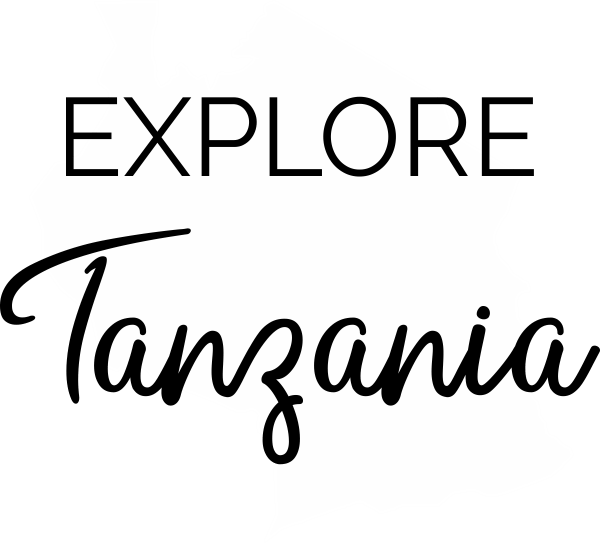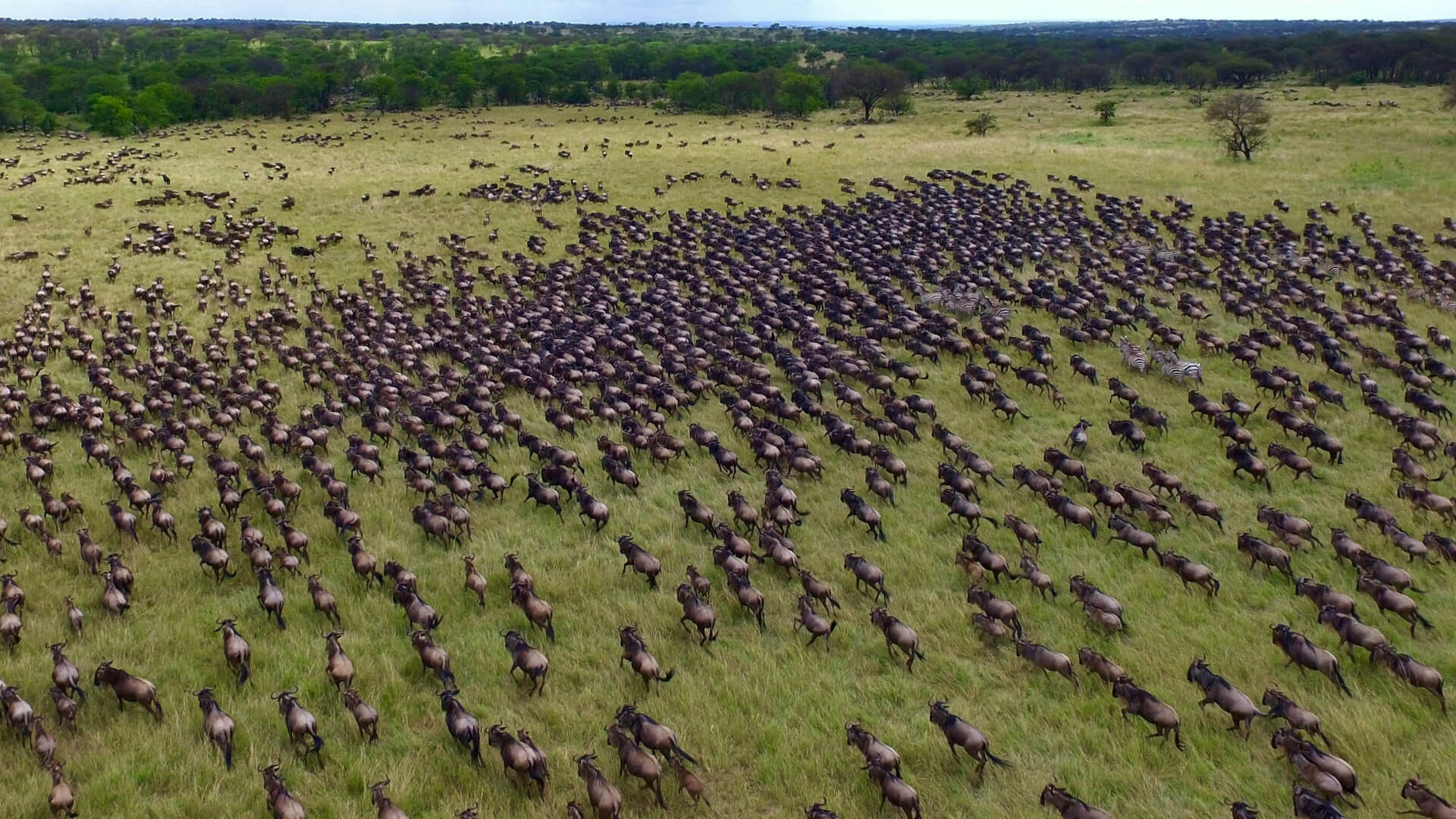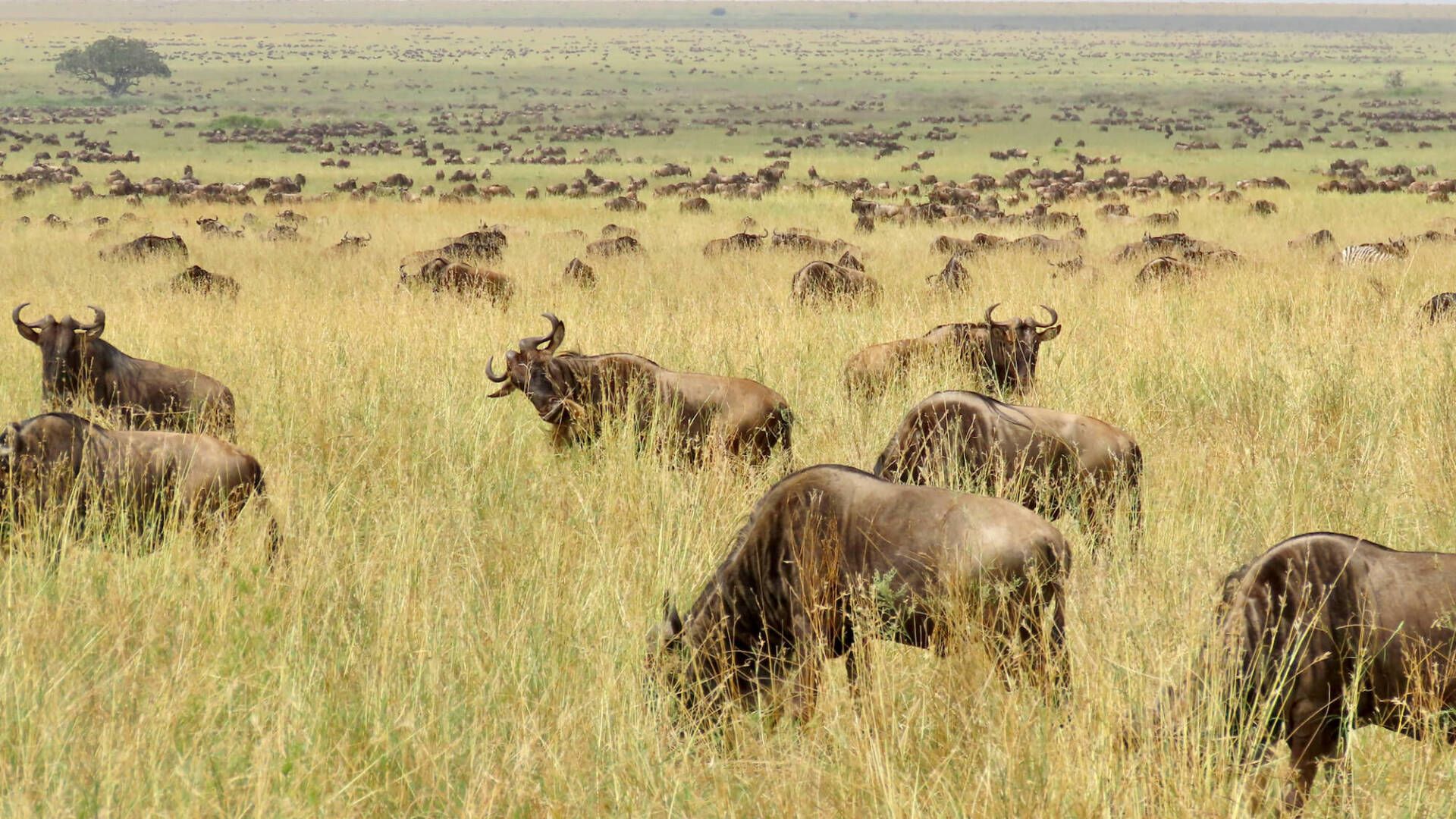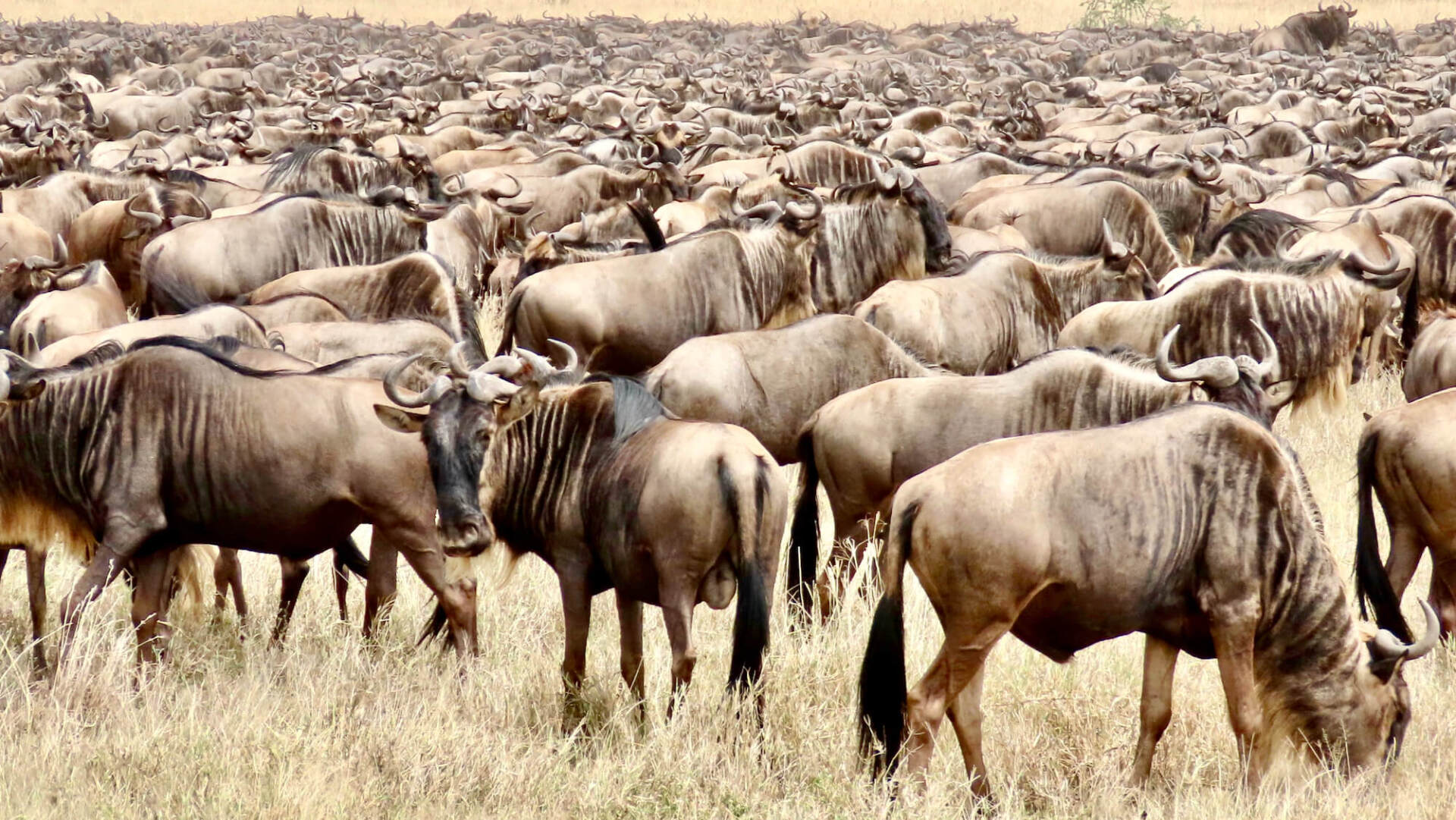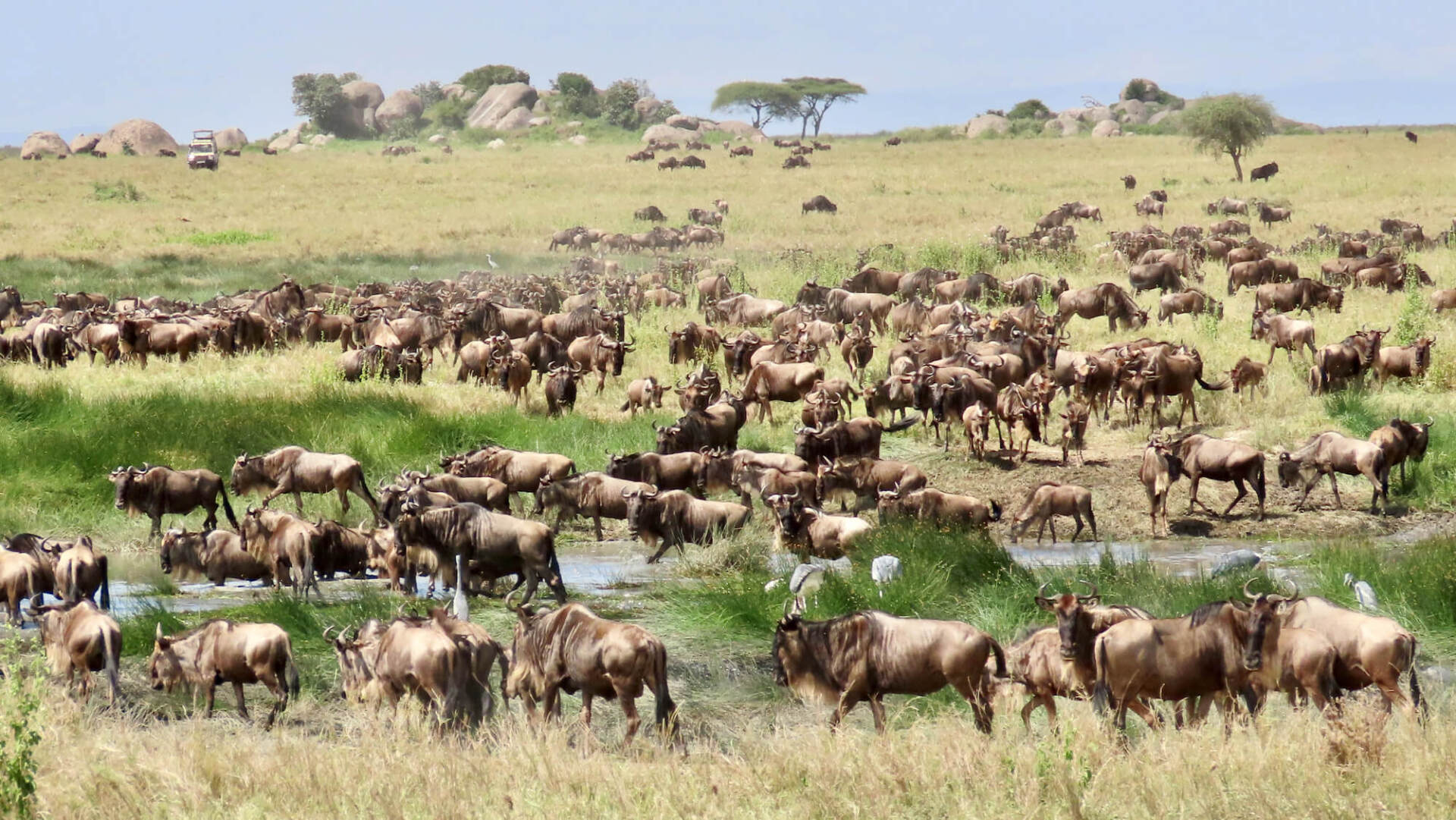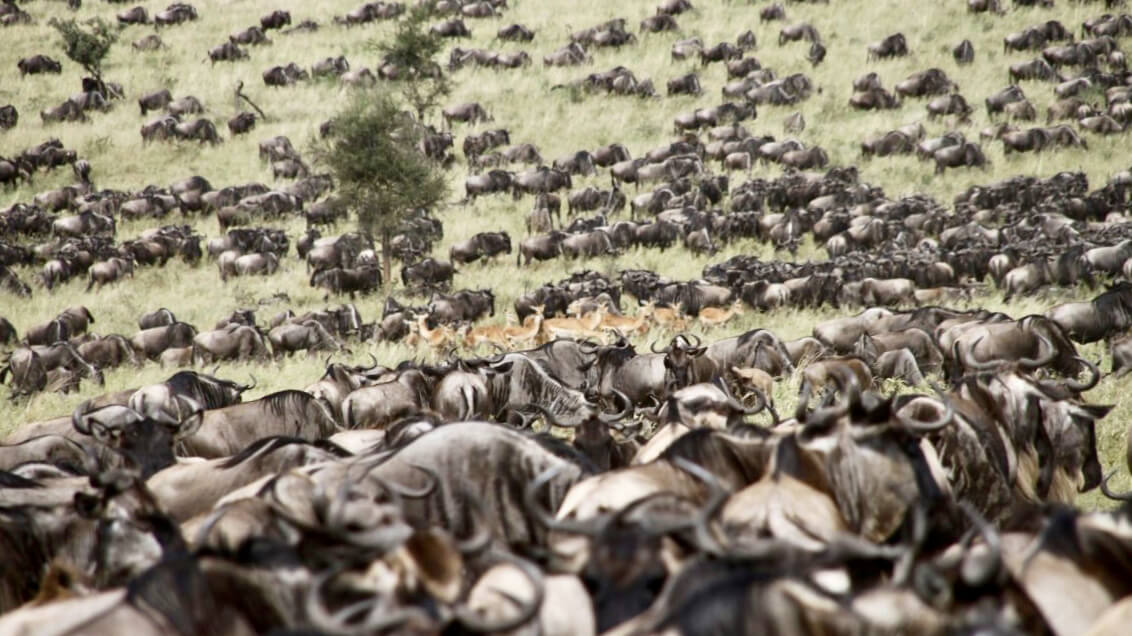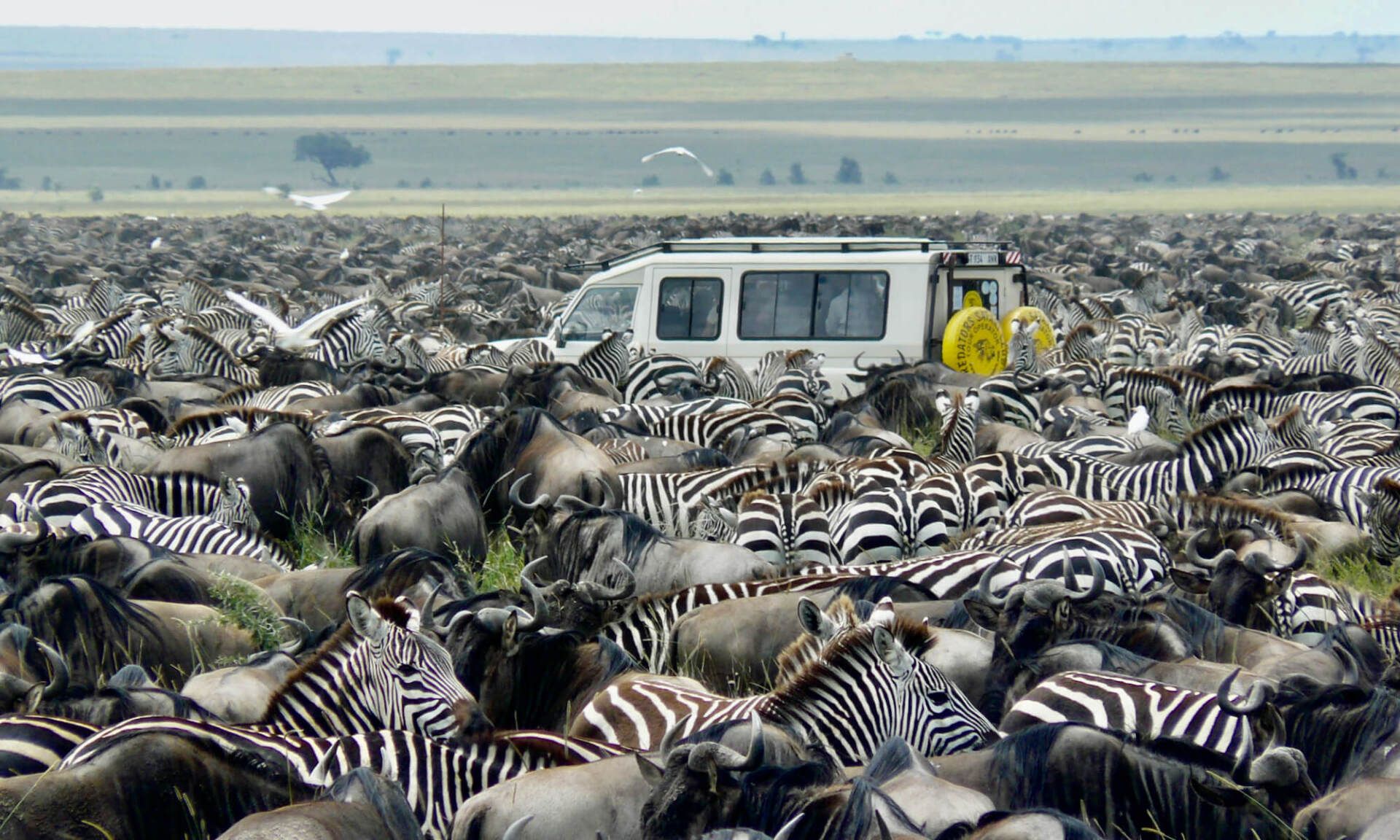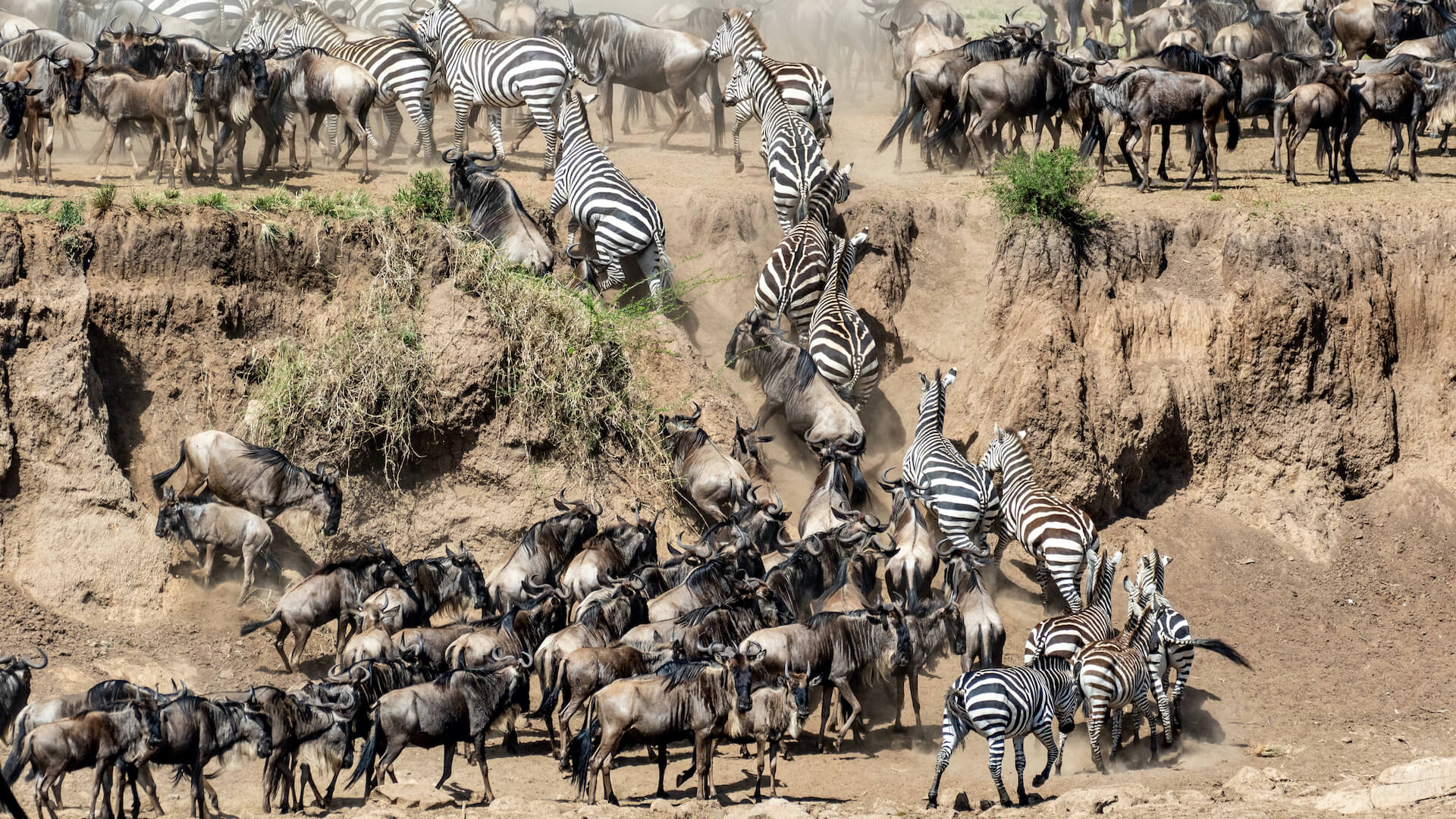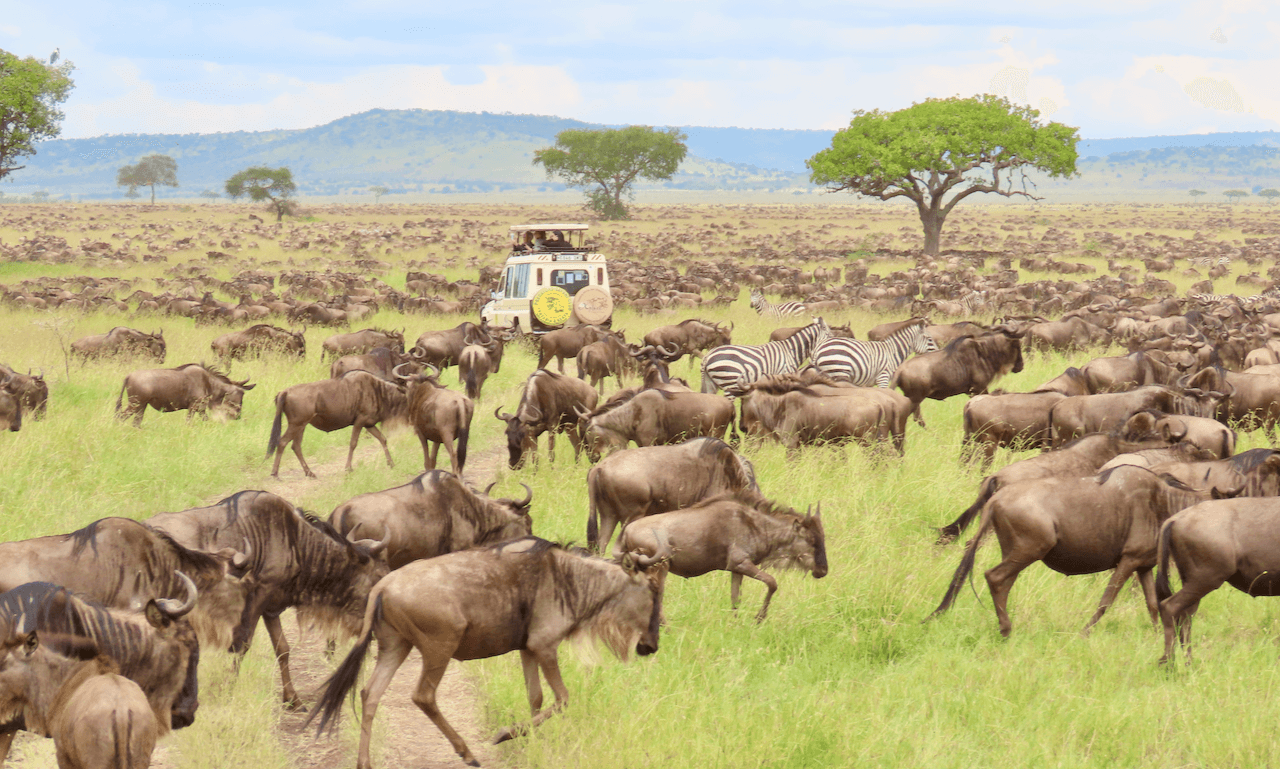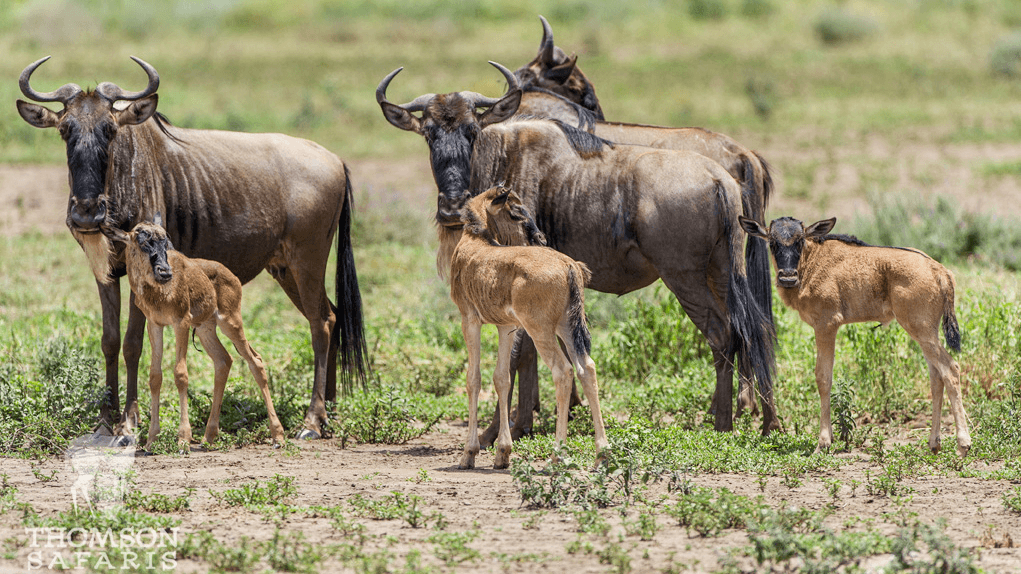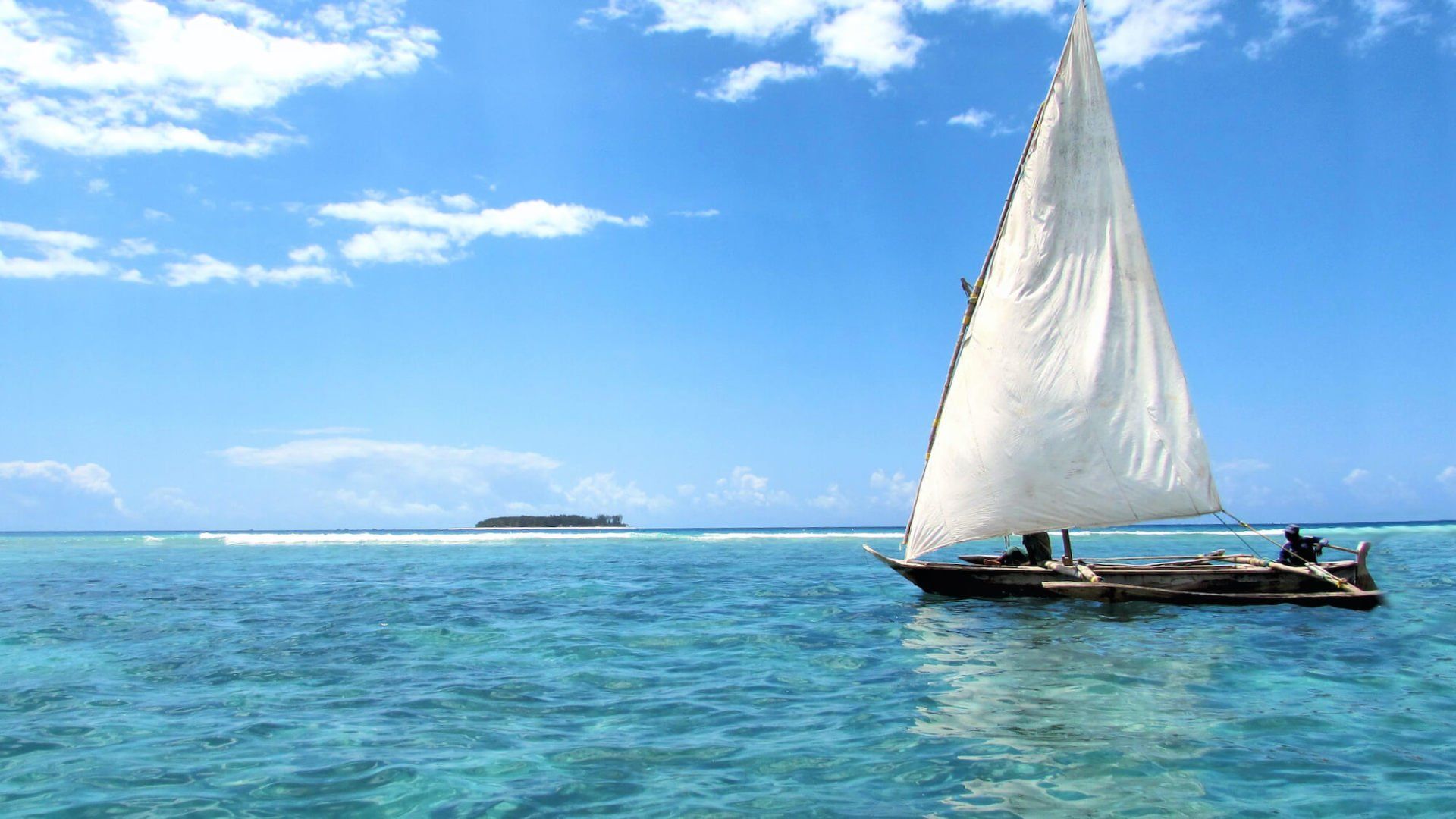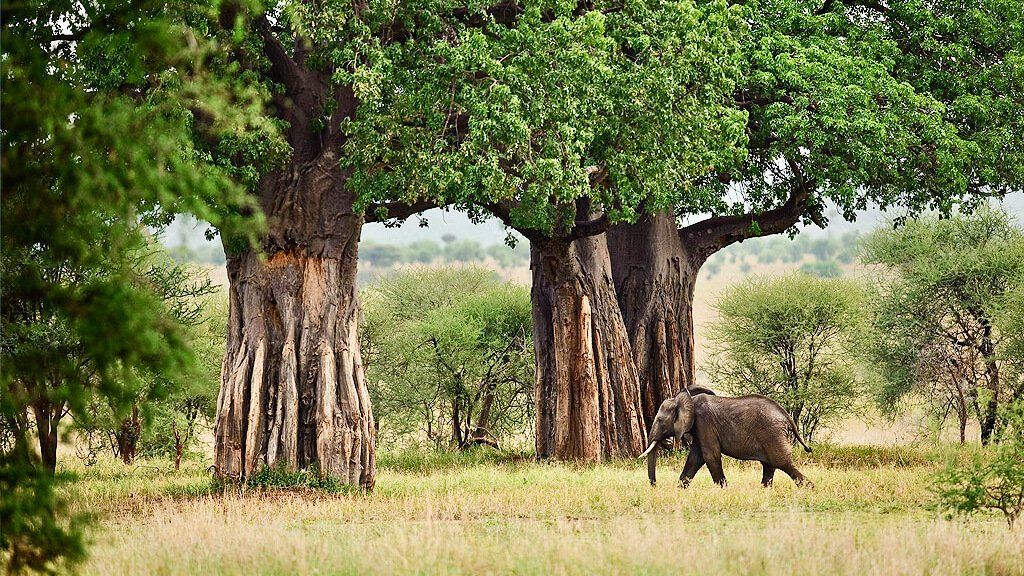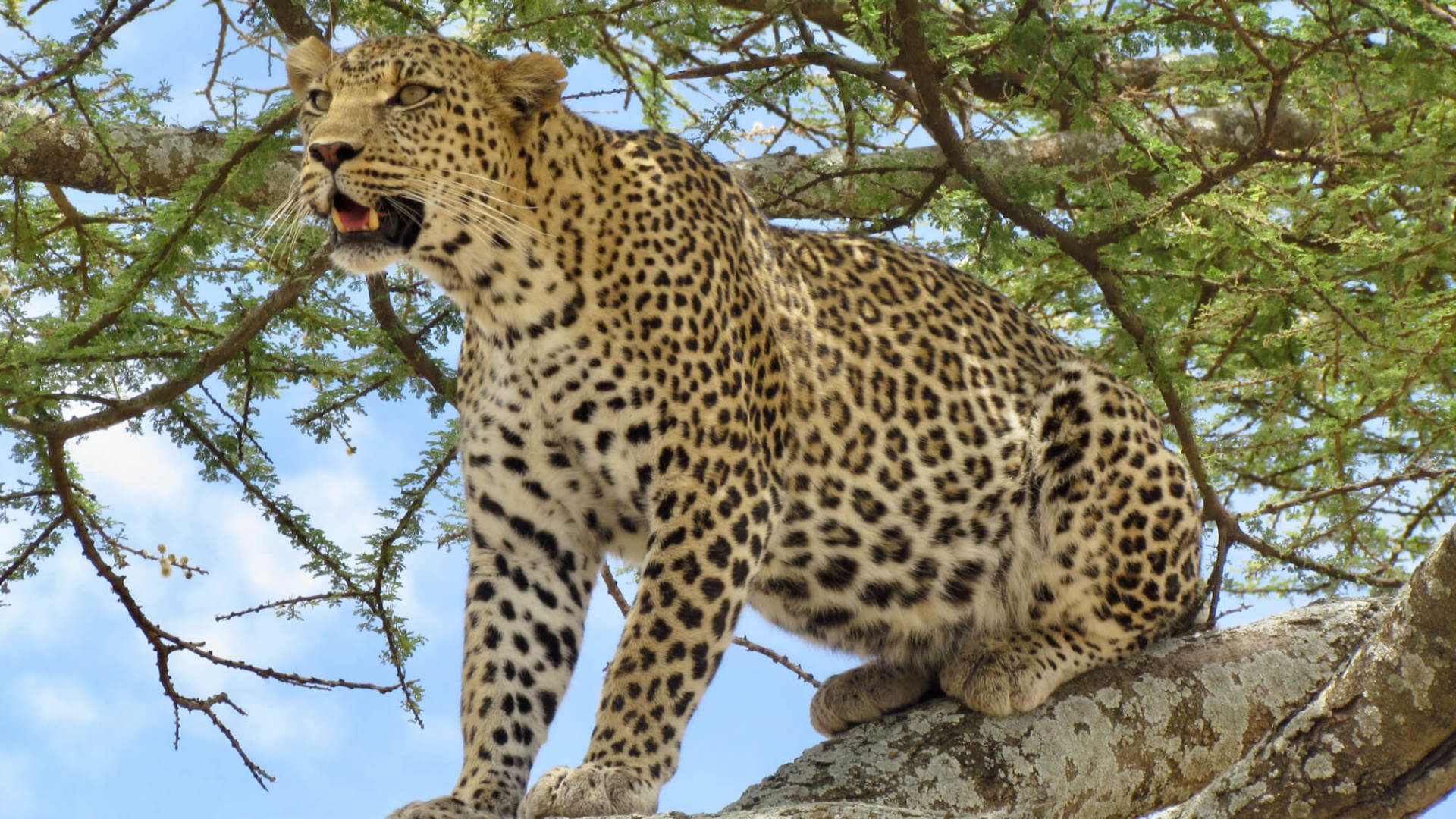Tanzania Wildebeest Migration
Also called the Great Migration, it is one of the most exciting natural wonders of the world.
The Wildebeest Migration is an ever-moving cycle of over 1.5 million wildebeests accompanied by large numbers of zebras and gazelles migrating between the Serengeti in Tanzania
and the Masai Mara in Kenya
in search of food and water.
Every year with the changing of the season, the Serengeti Masai Mara ecosystem sees over 1.5 million wildebeests and hundreds of thousands of zebras and gazelles migrate through the Serengeti and Masai Mara in search of food and water. The herds move in a clockwise circle and cover around 2,000 kilometres from the southern expanse of the Serengeti and the Ngorongoro conservation area over the border of Kenya to the Maasai Mara, back down to south Serengeti. During this time, they give birth, brave crocodile-infested waters and fend off hungry predators like lions, cheetahs and leopards.
It is the world's largest and furthest migration of land mammals. This natural phenomenon is listed as one of the Seven Natural Wonders of Africa.
Best Time To See The Migration In The Serengeti?
The great wildebeest migration takes place right through the year as the wildebeest continually seek fresh grazing and water as the seasons change. It generally follows a similar path that is relatively predictable. The precise timing of the wildebeest migration is entirely dependent upon the rainfall patterns each year. It works as follows:
The Wildebeest Migration Cycle
Find herewith a very general breakdown of more or less where the herds are during the year, bearing in mind that the entire migration is triggered by rain, which can be early, late or “on time”.
- Southern Serengeti and Ngorongoro Conservation Area - December to April
- Central Serengeti - April to May
- Western Serengeti and Lobo Valley - June to July
- Northern Serengeti and Masai Mara - July to October
- Migration return to the South - October to December
We’ve been planning migration safaris since 2004 and have all of the experience in putting you in the best place at the time of travel for the best great migration tours and experiences!
Prime Areas To See The Wildebeest Migration
Ngorongoro Conservation Area and Southern Serengeti
Calving Season: January / February / March
Although there is no real beginning or end to this migratory cycle, it is reasonable to call the calving season the start of the migration. Around
400 000 calves are born in the Ngorongoro conservation area and the Southern Serengeti during this time. These areas are known for their open plains which offer exceptional game viewing. The birthing season is truly spectacular with the highest calving rate in February when an average of
8000 wildebeests born daily. The wildebeests continue to mature on the short grass plains well into April, gaining strength for the long migration to the North following the rain and seeking new pastures.
CENTRAL SERENGETI
The Beginning Of The Northward Journey: April / May
In search of fresh pastures, the migration begins heading north through the Central Serengeti, ultimately aiming for the Mara River. Expect to see huge columns of wildebeest (sometimes up to 20km in length) barrelling their way up the Serengeti. This period is one of the best times for lion activity as the wildebeests cross the Kopjes (scenic rock formations) known for its lion prides. There is also plenty of resident game in the central area as well as the migrating herds in April and May.
The Green Season (April/May)
is the perfect time to plan your safari if you're would like to travel on more affordable rates. With possible short afternoon storms and the wettest part of the day being in the evening, we never had in all the years we are offering safaris game drive cancelled. The rains keeping the tourist crowds away, lodges lower their rates, flowers cover the Central Serengeti, you can enjoy comfortable temperatures with lush green countryside and a high concentration of animals.
WESTERN SERENGETI & LOBO VALLEY
Movement Towards The North: June
As the dry season approaches, the migrating herds start moving. They usually split into groups with some proceeding into the Western Corridor
and others passing north through the Lobo Valley.
The migration herds going west usually slows down as they reach the Grumeti River, often forming large groups before crossing the crocodile infested river. We, however, recommend that you do not book this area for river crossings as crossings are unpredictable as it mainly depends on the water level of the Grumeti River and the timing and duration varies each year widely.
The Lobo Valley
is in an isolated location in the northeast of the Serengeti boasting sheer natural beauty with thick woodlands, open plains, ranges of hills and stunning granite kopjes. Lobo Valley offers exceptional wildlife viewings with the migration herds moving through the area. It is home to a large concentration of elephants, buffaloes and big cats like lions, leopards and cheetahs.
This is also the rutting season and the plains are alive with testosterone-fuelled males chasing their chosen ladies.
NORTHERN SERENGETI (Kogatende, Lamai Wedge & Bologonja Springs)
River Crossings: July to October
These are the months of high activity and offer you the best chance to see river crossings
at the Mara River. Game viewing is superb with river crossings pretty much every day. There is lots of movement, as the herds tend to criss-cross back and forth as they follow the rain and head for greener pastures. It is probably the most scenic area in the entire park, with hills and kopjes that characterise the landscape. As it has abundant permanent water, it is a haven for animals during the dry season.
The Mara River
originates from the Mau Escarpment. It snakes across the northern tip of the Serengeti with the Kogatende area on the one side and the Lamai Wedge on the other, allowing visitors to enjoy river crossings in the Northern Serengeti from both sides of the river. The Mara River banks have at least ten crossing points throughout the Northern Serengeti.
Kogatende
is found along one of the main migratory corridors/routes of the great migration heading to the Mara River. The area has large acacias as well as tortilis trees and is home to several species of wildlife that reside in this area year-round.
The Lamai Wedge
is located between the Masai Mara National Reserve border and the Mara River. The area has beautiful vast open plains, dotted with umbrella thorn trees and abundant game.
Bologonja Springs
is a lush and idyllic spot hidden away in the remote reaches of the North Serengeti. The springs form the start of the Bologonja River, that feeds the Mara River further north. The nearby Larelemangi salt lick is a haven for wildlife and large herds of buffalo and elephant are regular visitors.
The Mara and Bologonja River areas both offer excellent game and river crossings views.
An experienced, patient guide
is essential to optimise your chance of seeing a river crossing. You could be waiting for the wildebeest to cross for hours as they mill around on one side of the river before one suddenly decides to take the leap of faith and the others follow. Sometimes you arrive just in time for the crossing!
NORTHERN TO SOUTHERN SERENGETI
The return: October to December
With the beginning of the short rainy season in November and December, the wildebeest migration will return to the short-grass plains of southern Serengeti and the Ngorongoro Conservation Area. The herds trek down through the eastern woodlands of the Serengeti, arriving back at the Southern Serengeti in December with about 90% of the cows heavy with the new season’s young. Finding the main herds during this time is challenging as they cover great distances daily.
Why Explore Plus For Your Migration Safari?
- With our wildebeest migration safaris, we aim to position you in the best location within the Serengeti, based on your travel date.
- We offer unlimited kilometres, offering you the benefit of game drives from sunrise to sunset!
- Our experienced guides
are permanently employed and have a true understanding of the migration and a wealth of knowledge about the area.
- Most importantly, we use a fleet of high-end safari vehicles.
Each of our vehicles undergo an extensive pre-safari inspection to ensure the safety of our clients and thereby guaranteeing the service quality of our ground operations. Our safari vehicles take up to 6 clients in 3 rows of seating (guaranteed window seat for all) with a pop-up roof, that can raise for wildlife viewing.
eXplore Plus Travel & Tours ensure the ultimate safari experience!
*** It is important to note that while the migration follows the same route each year, the precise timing of the migration is entirely dependent on seasonal rainfall patterns.

